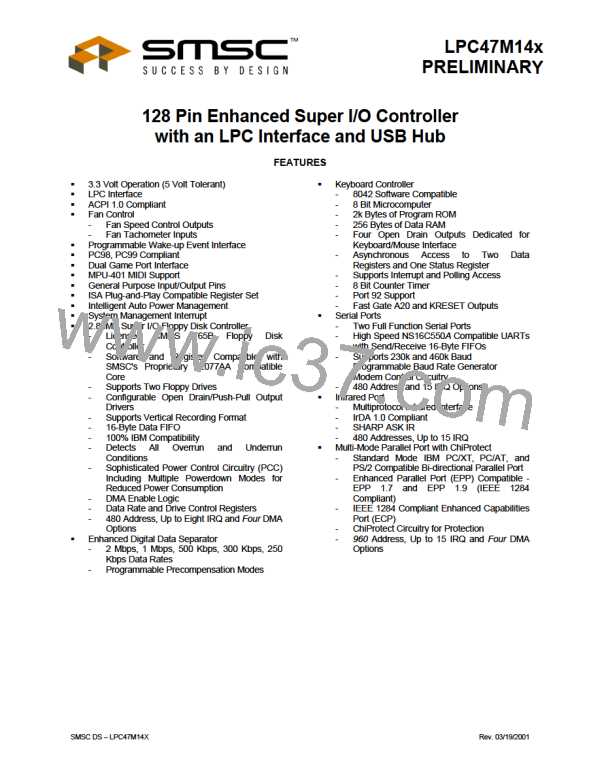6.14.3 GPIO Control
Each GPIO port has an 8-bit control register that controls the behavior of the pin. These registers are defined in the
“Runtime Registers” section of this specification.
Each GPIO port may be configured as either an input or an output. If the pin is configured as an output, it can be
programmed as open-drain or push-pull. Inputs and outputs can be configured as non-inverting or inverting. Bit[0] of
each GPIO Configuration Register determines the port direction, bit[1] determines the signal polarity, and bit[7]
determines the output driver type select. The GPIO configuration register Output Type select bit[7] applies to GPIO
functions and the nSMI Alternate functions.
The Polarity Bit (bit 1) of the GPIO control registers control the GPIO pin when the pin is configured for the GPIO
function and when the pin is configured for the alternate function for all pins, with the exception of the DDRC function
on GP43, the analog game port pins (J1X, J1Y, J2X, J2Y) and the either edge triggered interrupts. When the
alternate function is selected for the analog joystick pins (GP14, GP15, GP16 and GP17), these pins become open
drain, non-inverted outputs.
The basic GPIO configuration options are summarized in Table 55.
Table 55 – GPIO Configuration Summary
SELECTED
FUNCTION
DIRECTION
BIT
POLARITY
BIT
DESCRIPTION
B0
0
0
1
1
B1
0
1
0
1
Pin is a non-inverted output.
Pin is an inverted output.
Pin is a non-inverted input.
Pin is an inverted input.
GPIO
6.14.4 GPIO Operation
GPIO
GPIO
Configuration
Register bit-1
(Polarity)
Configuration
Register bit-0
(Input/Output)
D-TYPE
SD-bit
D
Q
GPx_nIOW
GPx_nIOR
GPIO
PIN
0
1
Transparent
Q
D
GPIO
Data Register
Bit-n
FIGURE 8 – GPIO FUNCTION ILLUSTRATION
SMSC DS – LPC47M14X
Page 112
Rev. 03/19/2001

 SMSC [ SMSC CORPORATION ]
SMSC [ SMSC CORPORATION ]